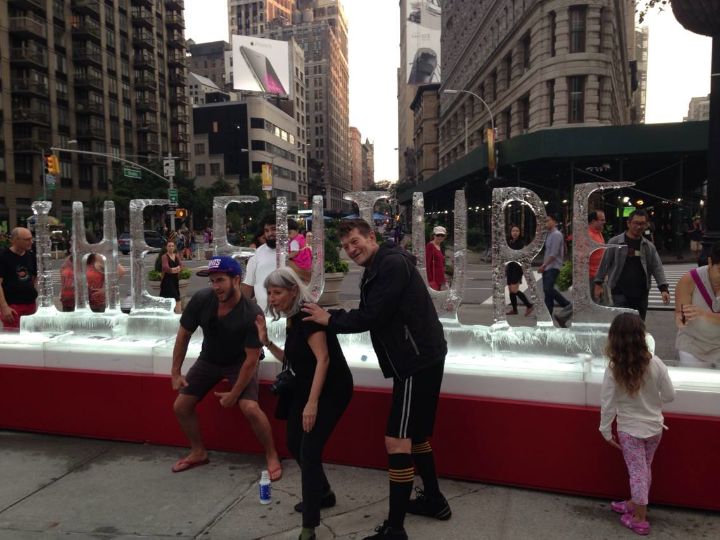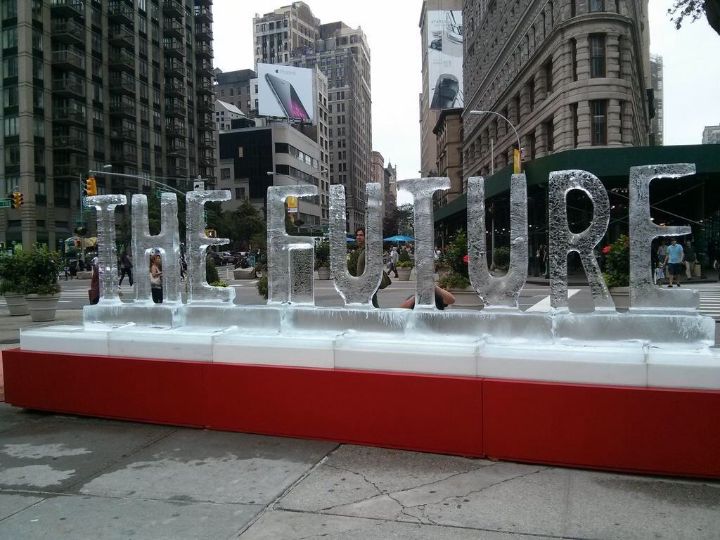John Weir
The 3 AM guy is planning my outfit for the giant melting ice sculpture at the Flatiron Bldg., where we’ll be anon. He’s going as a polar ice cap, of course. I want to go as him, which he’s not crazy about.

Me photographing people photographing melting ice, aka The Future.
The wifi is wonky at THE FUTURE, a big ice sculpture on 23rd Street across from the Flatiron bldg., NYC, so forgive me if I’ve posted this already, but: I’m at THE FUTURE, at the Flatiron building, watching ice melt. THE FUTURE is a big ice sculpture, and it’s been here since 9 AM, soaking up exhaust fumes from 5th Avenue and delighting European tourists streaming out of Madison Square Park. The sculpture was made by Nora Ligorano and Marshall Reese. I don’t know them. Neither does the 3 AM guy, who isn’t here yet. He decided he’s a polar ice cap, and he’s up north where ice caps live, waiting to melt. It won’t be long! He’ll wash up here in a minute, I think, clogged with whatever garbage he collects along the way.

THE FUTURE is backwards, because I’m behind it, a moment before the T in THE collapsed.
The 3 AM guy just washed up on a tide of ice water from the increasingly-less-frigid north. He picked up a couple of stripped cars along the way and some of those 6-pack-beer-can-plastic-holding-things that choke swans, and he is clutching a Big Gulp (the 3 AM guy is nostalgic for Mayor Mike) that’s been empty for quite a while, and he is already engaged in an argument with a perfectly nice man in cargo pants and a pressed shirt who asked him in an “I’m-not-starting-a-fight-or-anything” tone if the 3 AM guy really knew what the hell he was talking about with this quote climate change unquote thing, and the 3 AM guy said, “Beats me. All I know is it isn’t as cold up north as I thought it would be, and then – whoosh! – I was floating in the Hudson with the other garbage, and I thanked Congress and the wealth of nations for the quick commute!”
—
Now THE FUTURE, which is missing THE’s T, is lit up from below as night falls in NYC, and the 3 AM guy doesn’t like that sentence, he says it’s faux poetic, so here: I’m in a metal chair on a concrete slab of traffic island that splits 5th Avenue from Broadway. The Flatiron Building’s not flat, it’s a triangle curved at the apex, the 3 apices, and the sky above it is della robbia blue, blue of the robe, with white clouds. Cirrus clouds? I wish I knew the names of clouds! “Cirrus” means “ringlet of hair.” The sky’s robe blue with curling locks of hair, and the traffic on 23rd Street is continuous and loud, and there’s a billboard for the iPhone 6 jutting at an angle down Broadway, and fairy lights are strung around the lemonade stand in Madison Square Park. People with cellphones are standing in front of the melting ice sculpture taking pictures of what they can’t see because they’re busy taking pictures of it. Later, they will turn up in your Facebook feed. The pictures, not the people. Though maybe also the people. The 3 AM guy loves climate change, he loves floods and famine and ruined tunnels for the R train, which I took here, because they just fixed the ruined-by-Hurricane-Sandy R train tunnel under the river from Brooklyn into Manhattan last week, and I like the R train! The 3 AM guy says, “Let it flood, you’ve got your mother’s car, what are you complaining? Pump exhaust and carbon monoxide fumes into the air while you cry about dry lakes in the Levant, hypocrite.”
—
I’ve got 30 minutes left to watch THE FUTURE melt and think deep thoughts – Ha!, says the 3 AM guy – and I’m thinking about the last full night I remember spending in Manhattanworld before I moved to the Republic of Brooklyn, BKNY, 18 months ago, after 33 years – lifetime of Christ! – living in one illegal sublet or another up and down Melville’s Island of the Manhattoes – I lived in two different apartments on West End Avenue, I lived on Avenue A with a boyfriend (as close as I’ll ever get to married), I lived in somebody’s mother’s temporarily empty apartment (she was in Florida) in a brutalist apartment complex under the Brooklyn Bridge, I lived on First Street in EVil for 13 years in an apartment that was painted bubble gum orange, I lived with 2-lawyer families in a building on Columbus Avenue, and the last place I lived in Manhattan was in BatShip, 47th Street & 10th Ave up the Street from the Battleship Intrepid, in a railroad flat between two gay bars, Hardware and BarTini, and that’s where I was when Hurricane Sandy happened, and Manhattan was blacked-out from the Battery to about 28th Street, for like a week.
—
Lower Manhattan was dark! I went out one night from 47th Street and walked downtown, through Hell’s Kitchen into Chelsea and the West V and then across town to the East V, at about 9 PM, and then all the way down to the Staten Island Ferry, and then I walked home, and the only light I saw was a pizza parlor on 24th Street whose industrious owners had hooked up their lights to a generator, and they were pumping a circle of light and a lot of pizza into the darkness, Edward Hopperishly. Some restaurants in the West V were open and lit by candlelight, and there were men in yellow safety vests standing around the R train entrance at Whitehall in Lowest Manhattan, pumping water out of the tunnel and barking at me to get away, so I got away.
—
On the way home, I stopped at the intersection of 7th Ave & Greenwich Ave & 11th Street, stood in the middle of the street, there were no cars, no lights, it was kind of thrilling, and the big wrecked remains of St. Vincent’s Hospital were gaping and mouthy and visible against the sky. It was the intersection where I met my first boyfriend, and where my best friend died, and though I’d lived in Manhattan for three decades, and my father worked for 45 years in the RCA Building – if I have a center it’s Rockefeller Center – : though I tell myself I’ve known Manhattan in pretty much all of its moods, since I was 3 months old, nonetheless, I had never stood in the middle of the empty street in the dark of night surrounded by unlit buildings in the silence of 11 PM, with my arms out, thinking of my friend who died in the hospital that was no longer there, and there was a mild breeze, and somewhere in the ghostly past poor Herman Melville, failed novelist, was trudging home from his dreadful job at the Customs House at the foot of Gansevoort Street – named for his father-in-law’s family! – and I thought, well, even Hermie must have had gas lights.
—
And I mean I was living a mile from the Twin Towers on 9/11 and walked down there in time for the second Tower to fall, and people were walking uptown towards and away from me in face masks and covered with white ash, and the East Village was patrolled by armored tanks for maybe a month afterwards, but even that was not as scary and weird as the whole thumb-stump of Lower Manhattan dark and underwater, and you make of disaster what you can! You go for a long walk and think about the dead, and stand in the middle of the street. But I wouldn’t want that opportunity again, which is why I’m posting this, and the 3 AM guy agrees.

People gamboling before The Future as it dissolves.
Save













